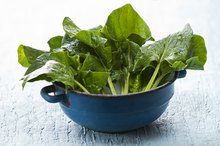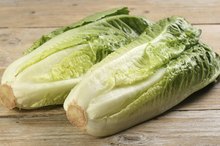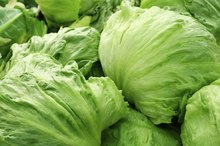What does fact checked mean?
At Healthfully, we strive to deliver objective content that is accurate and up-to-date. Our team periodically reviews articles in order to ensure content quality. The sources cited below consist of evidence from peer-reviewed journals, prominent medical organizations, academic associations, and government data.
- National Institutes of Health: Dietary Supplement Fact Sheet: Iron
- National Institutes of Health: Dietary Supplement Fact Sheet: Calcium
- Harvard School of Public Health: Fiber: Start Roughing It!
- Harvard School of Public Health: Vitamins
The information contained on this site is for informational purposes only, and should not be used as a substitute for the advice of a professional health care provider. Please check with the appropriate physician regarding health questions and concerns. Although we strive to deliver accurate and up-to-date information, no guarantee to that effect is made.
Leafy green vegetables deserve a place in your diet because they contain so many essential vitamins and minerals. Both collard greens and spinach are low in calories, but high in nutritional value. If you are unsure which variety of leafy green vegetables to include in your diet, comparing the nutrition of spinach versus collard greens may make that decision easier.
Iron
Adding leafy green vegetables to your daily diet is one way to increase your intake of iron. Iron is a mineral that enables your body to produce red blood cells, as well as ensure that your entire body has the oxygen it needs to function properly. A 1 cup serving of cooked spinach provides significantly more iron than 1 cup of cooked collard greens. This serving of spinach contains 6.43 mg of iron compared to the less than 1 mg present in the same amount of collard greens.
- Adding leafy green vegetables to your daily diet is one way to increase your intake of iron.
- A 1 cup serving of cooked spinach provides significantly more iron than 1 cup of cooked collard greens.
Calcium
Raw Spinach and Magnesium
Learn More
Important for strong bones and teeth, calcium is a mineral present in leafy green vegetables, including spinach and collard greens. Calcium also plays a role in the function of your hormones, nerves and muscles. One cup of cooked spinach supplies you with 245 mg of calcium. The same serving size of cooked collard greens contains less calcium, with 74 mg.
- Important for strong bones and teeth, calcium is a mineral present in leafy green vegetables, including spinach and collard greens.
Fiber
Fiber is another nutrient present in larger doses in spinach than in collard greens. Your diet should include at least 20 g of fiber per day, the Harvard School of Public Health reports 5. Fiber helps prevent constipation and may also help lower your cholesterol and prevent heart disease. A 1 cup serving of cooked spinach contains 4.2 g of fiber while the same amount of cooked collard greens only contains 0.4 g of fiber.
- Fiber is another nutrient present in larger doses in spinach than in collard greens.
- A 1 cup serving of cooked spinach contains 4.2 g of fiber while the same amount of cooked collard greens only contains 0.4 g of fiber.
Vitamin C
Nutritional Value of Mesclun Greens vs. Romaine Lettuce
Learn More
Your body relies on vitamin C for infection control, as well as to be an antioxidant that helps neutralize harmful free radicals. Vitamin C also promotes healthy formation of collagen, a substance required for your bones, teeth, gums and blood vessels. Both spinach and collard greens supply a healthy dose of vitamin C, but spinach contains almost double. One cup of cooked spinach has 17.6 mg of vitamin C, and 1 cup of cooked collard greens contains 9 mg.
- Your body relies on vitamin C for infection control, as well as to be an antioxidant that helps neutralize harmful free radicals.
- Both spinach and collard greens supply a healthy dose of vitamin C, but spinach contains almost double.
Vitamin A
Vitamin A is important for healthy eyes, but also plays a role in healthy skin and cells. Spinach is a vitamin A powerhouse and contains significantly more vitamin A than collard greens. A 1 cup serving of cooked spinach supplies 18,866 IU of vitamin A. One cup of cooked collard greens provides 2,109 IU of vitamin A.
- Vitamin A is important for healthy eyes, but also plays a role in healthy skin and cells.
- A 1 cup serving of cooked spinach supplies 18,866 IU of vitamin A.
- One cup of cooked collard greens provides 2,109 IU of vitamin A.
Related Articles
References
- USDA Nutrient Database; Nutrient Data Laboratory
- University of Illinois Extension: Watch Your Garden Grow
- National Institutes of Health: Dietary Supplement Fact Sheet: Iron
- National Institutes of Health: Dietary Supplement Fact Sheet: Calcium
- Harvard School of Public Health: Vitamins
- Collards, raw. FoodData Central. U.S. Department of Agriculture. Published April 1, 2020.
- National Institutes of Health National Cancer Institute. Cruciferous vegetables and cancer prevention. Updated June 7, 2012.
- Pollock RL. The effect of green leafy and cruciferous vegetable intake on the incidence of cardiovascular disease: A meta-analysis. JRSM Cardiovasc Dis. 2016;5:2048004016661435. doi:10.1177/2048004016661435
- Blekkenhorst LC, Bondonno CP, Lewis JR, et al. Cruciferous and total vegetable intakes are inversely associated with subclinical atherosclerosis in older adult women. J Am Heart Assoc. 2018;7(8). doi:10.1161/JAHA.117.008391
- Anderson JW, Baird P, Davis RH, et al. Health benefits of dietary fiber. Nutr Rev. 2009;67(4):188-205. doi:10.1111/j.1753-4887.2009.00189.x
- Jia YP, Sun L, Yu HS, et al. The pharmacological effects of lutein and zeaxanthin on visual disorders and cognition diseases. Molecules. 2017;22(4). doi:10.3390/molecules22040610
- Scott O, Galicia-Connolly E, Adams D, Surette S, Vohra S, Yager JY. The safety of cruciferous plants in humans: a systematic review. J Biomed Biotechnol. 2012;2012:503241. doi:10.1155/2012/503241
- National Kidney Foundation. Kidney stone diet plan and prevention. Updated June 2019.
- Collards, cooked, from canned, fat not added in cooking. FoodData Central. U.S. Department of Agriculture. Published April 1, 2020.
Writer Bio
Sara Ipatenco has taught writing, health and nutrition. She started writing in 2007 and has been published in Teaching Tolerance magazine. Ipatenco holds a bachelor's degree and a master's degree in education, both from the University of Denver.









